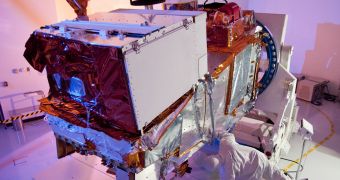Officials at the American space agency announce the successful integration of the last of the five science instruments that are scheduled to launch aboard the NPOESS Preparatory Project (NPP) climate and weather satellite. The spacecraft – a polar-orbiting satellite that is scheduled to take to the skies at the end of next year – was originally classified as a National Polar-orbiting Operational Environmental Satellite System (NPOESS) precursor. The mission has since been restructured.
The last instrument to be added aboard the satellite is the advanced atmospheric sensor called the Cross-track Infrared Sounder (CrIS). It was developed and constructed by Fort Wayne, Indiana-based ITT Corporation, and it has recently been delivered to Boulder, Colorado-based Ball Aerospace & Technologies Corp. The second organization is one of the main contractors for the mission, and its job is to perform the integration and checkout procedures associated with the NPP spacecraft. Ball also
“Successful integration of CrIS brings us one step closer to launching the nation’s critically needed, next weather satellite. This significant milestone demonstrates the flexibility of Ball’s BCP platform to easily accommodate multiple instruments even when requirements change over the course of the program,” explains the vice president and general manager for Ball Aerospace Civil and Operational Space business unit, Cary Ludtke.
“CrIS is part of the five-instrument suite that will allow the NPP satellite to collect and distribute remotely-sensed land, ocean, and atmospheric data to the meteorological and global climate change communities. The advanced sensor suite will provide atmospheric and sea surface temperatures, humidity sounding, land and ocean biological productivity and cloud and aerosol properties,” Ball Aerospace announces in a press release.
The fifth instrument will work closely with another tool from the NPP scientific suite, the Advanced Technology Microwave Sounder. Together, the two will produce viable atmospheric temperature, moisture and pressure profiles, at a global scale. The other three instruments that will fly aboard the satellite include the Visible/Infrared Imager/Radiometer Suite, the Ozone Mapping and Profiler Suite, and the Cloud and Earth Radiant Energy System, e! Science News reports.

 14 DAY TRIAL //
14 DAY TRIAL //